Goldenrod is a flowering North American herb that has many uses and benefits. Foraging and using goldenrod at summers end will have you reaping its vast rewards.
This post may contain affiliate links at no additional cost to you. By making your purchases through the links on this website, IMSL may make a small percentage at no direct cost to you. IMSL only promotes products we use & truly believe in. Please refer to my Privacy & Disclosures for further information. IMSL thanks you for your support!
Goldenrod, whose latin name is “Solidago spp.” translating to “make firm, whole, and healthy”, comes from the Asteraceae botanical family. It comes into bloom late August in our area. Just about the time ragweed does.
Not the season for goldenrod? There is still time to prepare for the upcoming allergy season if you choose.

MISCONCEPTIONS OF GOLDENROD
Unfortunately, goldenrod is the recipient of much wrath from those who suffering seasonal allergies. And mistakenly so.
Although you cannot rule out the risk of developing an allergic reaction to any flowering plant, you would have to sniff in the pollen of goldenrod directly from the flower itself as its pollen tends to be very heavy. Unlike ragweeds pollen which is light and takes flight via the wind.
It is goldenrods prolific, heavy pollen that makes it such a feast for our pollinators. Considered the last source of pollen for honey bees, bumble bees, and so many more pollinators & insects when in bloom, it is no wonder it’s an amazing nectar source for winter storage for them.
My hill literally glows golden and comes alive with buzzing during the height of the flowering season. You can be sure I take only what I need and leave the rest for my winged friends.
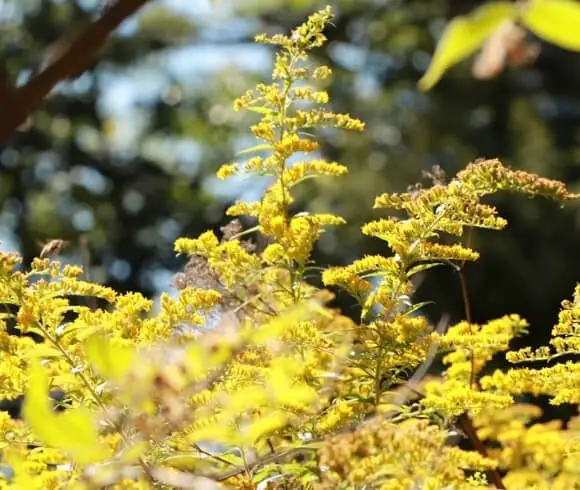
THE MANY BENEFITS OF GOLDENROD
The genus name of this herbal plant is derived from the Latin word “Solido”, literally translating “to heal”. And heal is what this plant does.
Goldenrod is a natural dye, medicinal, & healing. All parts of this herbal plant are useable.
- URINARY ISSUES – Goldenrods astringent & antiseptic properties have long been used to tighten, strengthen, and treat UTI issues. The German Commission E has even approved Goldenrod for use in treatment of urinary and bladder inflammations
- MUSCLE & ARTHRITIS PAIN – Oil infused with goldenrod’s flowers & leaves used in making salves & rubs, like my dandelion salve, help to relieve soreness from both muscle overuse and arthritic pain
- RESPIRATORY ISSUES – Respiratory issues stemming from seasonal allergies, colds, and sore throats will benefit from the use of goldenrod according to the book written by Patricia Kyritsi Howell, “Medicinal Plants of the Southern Appalacians”
- NATURAL DYE – Goldenrod has long been used as a natural dye. The flowers yield a warm, yellow color to most cottons, wool, and silk fabrics. I really enjoyed reading master dyer Rebecca Desno’s information on natural dyeing and you can find her information HERE
HOW TO FORAGE GOLDENROD
As with any foraged plant, proper plant identification is key. Fortunately, Goldenrod is not difficult to identify, and can be found readily in fields and forest edge. As with many plants, look-a-likes can often be mistaken, sometimes with hazardous results.
Goldenrod is no different in this regard. Plants from the daisy family, Senecio, have a similar look about them to someone new to foraging goldenrod. As with any foraging expeditions, when in doubt, leave it!
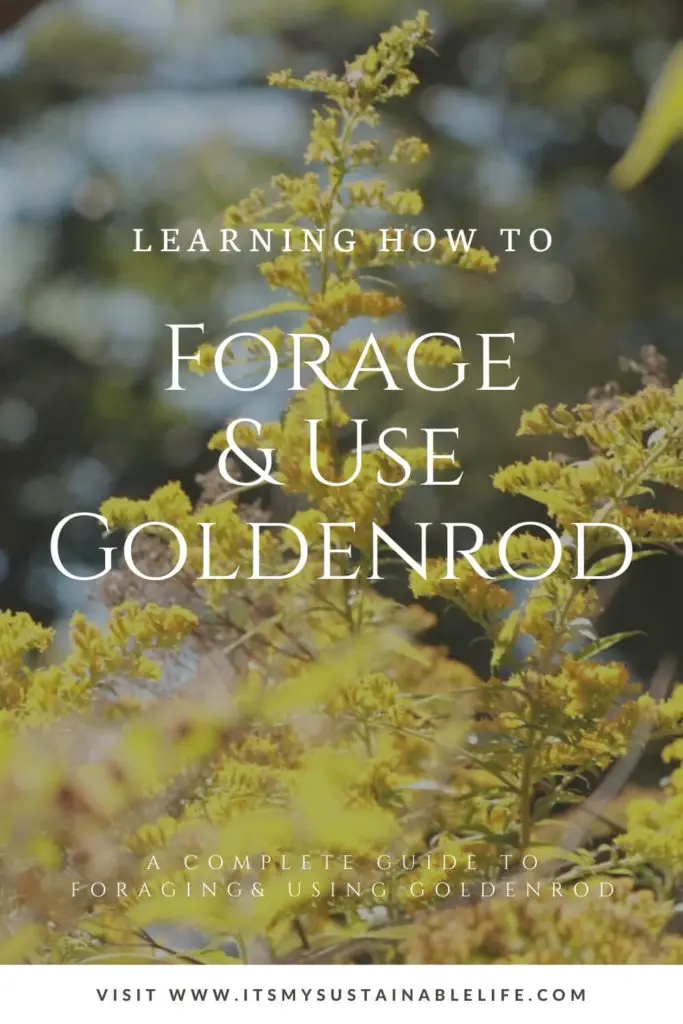
Fortunately, I don’t have to journey far to forage goldenrod as I have a hill that prolifically grows this valuable herbal remedy and nectar source.
A quick note, when foraging goldenrod, be mindful of the flowerhead’s inhabitant’s. It’s not unusual to find insects, nesting within the flower clusters. When foraging be sure to give a good shake to dislodge and tiny visitor’s.
IDENTIFYING GOLDENROD
Goldenrod typically grows in dry or semi-dry areas. It likes sunny areas. It’s a tall plant that grow to heights of 7 feet! Mine is usually right around 5-6 feet and grows on my full sun, hot, and dry hill.
Depending on the season, goldenrods flowers will appear mid to late summer and often last through early fall, often into October. The leaves are 2-5 inches in length and are covered in tiny hairs. They are long, narrow, and oval in shape coming to a point on either end. Some have said they carry an anise smell. I have not found that to be the case.
Goldenrods flowers, a brightly colored yellow, grow mostly on one side of a long branch/stem and often hang over or droop downward.
I do not recommend harvesting Goldenrod that is found alongside roads, or high traffic areas due to possible contaminations.
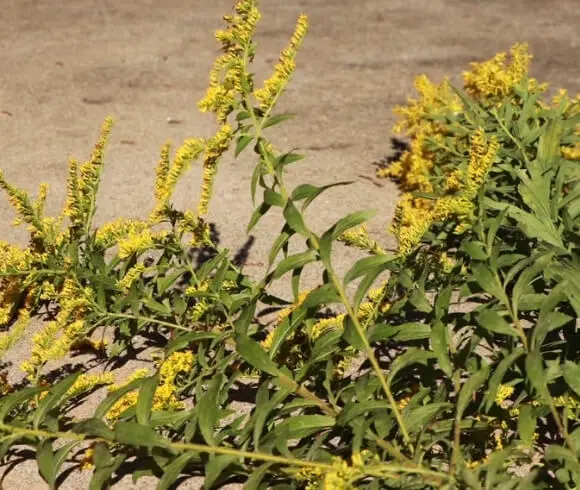
Note in the image above, the younger, more tender leaves in the top 3-4 inches (near the flower) are lighter in color. It’s these leaves that can be used by adding a few to salads and snacking when you harvest them before the flowers bloom. These are the leaves you want to dry and store for use in tea’s when possible. Again, prior to the flower blooming, anytime from seedling to blooming.
GROWING GOLDENROD
Goldenrod is a very easy plant to grow, requiring only average soil, and is hardy to zone 3. Growing from seed may be a bit tricky, so it’s best to ask a friend who grows it for a root or look to your garden centers for established plants. Once established in the garden, the roots are strong and hardy, and need only the occassional watering when dry spells come around.
Or you could be like me, and let the insects, pollinators, and birds seed this wonderful plant into my space without me asking 😉 By letting it grow for several years, I now have a plethora of golden blooms each fall for our bee’s and me to boot!
TIMING THE GOLDENROD HARVEST
First and foremost, choose the plant you will be harvesting from wisely. Pick a strong, hardy looking plant with little to no indications of disease (goldenrod is prone to powdery mildew & rust) or stress.
When it comes to harvesting any herb, the first question I ask is, “when’s the best time to harvest it”. Attention need’s to be paid to the “when” to harvest when it comes to herbs stages of growth.
- TIME OF DAY – As with most herbs that I forage and harvest, late morning seems to be the best time of day to harvest them. I can be sure that the dew has completely dried on the plant, and the sun is not at it’s peak
- GOLDENROD LEAVES – As noted above, pick your leaves prior to the flower blooming, anytime from seedling to blooming is best. I try to save the leaves from plants that the blooms are just at the opening stage
- GOLDENROD FLOWERS – Harvest the flowers when first blooming and until the flower clusters are no more than 1/3 browned. At that time it’s best to leave the remaining as they’re too old to utilize
- GOLDENROD STEMS – I add a few stems finely chopped along with the freshly harvested flowers when making my tincture & oils. Most times, I compost them
- GOLDENROD ROOTS – Harvest older roots, several year old plants, after the first hard frost. Wash them well, dry, and cut into small fine pieces. I let mine air dry, weather permitting, completely over the course of several months, but they can certainly be dehydrated via a dehydrator if you prefer a speedy process. Should you heat with wood as we do, drying over the woodstove is an effective way to dry your harvested herbs
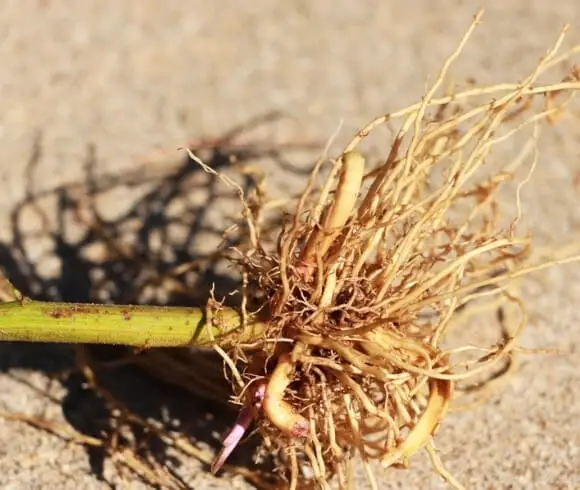
GOLDENROD USES
Your foraged goldenrod has so many uses! A few of my favorites I found are to infuse oils for making salves (visit my Calendula Oil article for step-by-step instructions on how I do this), tea infusions (visit Herbal Infusions on the best method), infusing honey (in the same manner as I do my honey fermented garlic), and creating tinctures (just as I do my Elderberry Tincture).
GOLDENROD TINCTURE
I use the same method as mentioned above, in my elderberry tincture article, to make a goldenrod tincture. You can use the flowers, the leaves, and the roots. I prefer to make a root tincture, as I feel the highest frequency of energy in plants resides within the roots.
To make, simply fill a small mason jar 1/4 to 1/2 way with your plant part(s), and fill the jar completely with at least 80 to 100 proof vodka. Let set in a dark cupboard for a minimum of 4-6 weeks. I prefer to leave mine even longer than the 6 weeks. Strain and store in an air-tight jar out of direct sunlight, preferrably and amber tinted glass bottle. Read all my recommended apothecary essentials article for a complete list!
NOTE: Some may have adverse reactions if sensitive to plants in the Asteraceae family.
Goldenrod tincture may be taken in 2 to 4 ml amounts 3 times per day. (1.5 in 40%)
GOLDENROD TEA INFUSIONS
To enjoy goldenrods full benefits, a deep infusion is recommended.
To infuse, simply take one cup, approximately 1 oz, of your dried flowers and leaves and cover with boiling water. Lightly cover, not tight, and allow to steep overnight.

Use your infusion by taking 1 cup up to 3x per day heated or cooled for urinary tract infections. For cold and similar respiratory and sinus issues, combine yarrow along with the goldenrod when infusing.
These infusions also make for a wonderful addition when making your own cough drops (post coming soon) and syrups.
GOLDENROD INFUSED OIL
Make an infused oil for use in making salves and balms. Goldenrod Salve recipe can be found below.
I love to use the power of the sun when infusing oils.
To make your goldenrod infused oil fill a jar at least 1/2 way with dried flowers and cover the flowers with your favorite oil (I typically use organic EVOO), cover with a cloth only, and leave in a sunny windowsill for a few weeks. Strain and store in a sealed jar preferrably in a dark cupboard.
GOLDENROD INFUSED HONEY
Using the same method as my honey fermented garlic, to infuse goldenrod into honey, fill a jar with fresh flowers and leaves, being sure to not pack tightly. I don’t worry if there are a few small stems in there as well.
Cover the flowers with fresh, raw honey. Loosely cover, tightening the cover every couple of days and turning the jar upside down and then backover to loosen the cover once again. This allows for a good coating of all flowers.
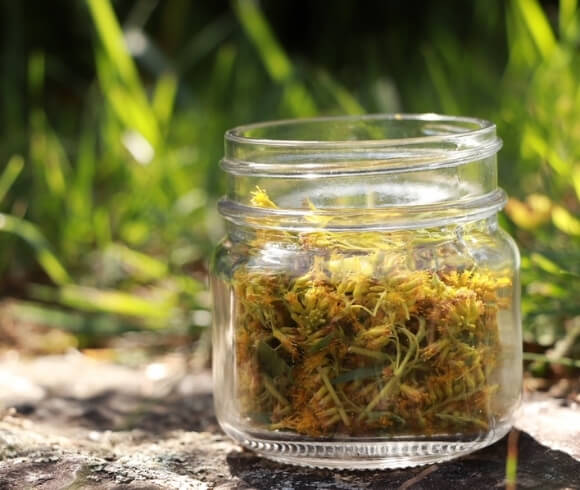
Allow 4 weeks for the infusion. You will note that the honey will become a bit more runny as time progresses. This is normal. Strain the flowers from the honey and store in a sealed container in a dark cupboard.
Use this delicious and beneficial goldenrod infused honey in tea, or take by the spoonful!
GOLDENROD SALVE RECIPE
Use your goldenrod oil to make an easy salve for use on sore, tired, and achy muscles and joints.
To make your salve…
- Melt together using a double boiler, 3.5 oz of oil (about 1/2 cup) with 0.5 oz (about 1.5 Tbl) of beeswax
- Pour into a container of your choice
- This recipe will make approximately 3 2 oz tins
Generously massage into any area’s or joint’s that require it. Feel free to re-apply as often as needed.
As with any herbal remedy or program, always check with your healthcare provider prior to beginning or using goldenrod. For the majority, goldenrod makes for a beautiful & healthy addition to our home apothecaries.
Do you already utilize goldenrod’s benefits?
Love, Light, & Laughter ~

DISCLAIMER
Recommendations and or suggestions made by this blog regarding husbandry and or herbal remedies etc. are not meant to replace solid advice from qualified professionals. None of the information on this blog has been evaluated by the FDA. Products or remedies mentioned are not intended to diagnose, treat, cure or prevent disease. Please do your due diligence. Research, talk to qualified professionals and proceed at your own risk.

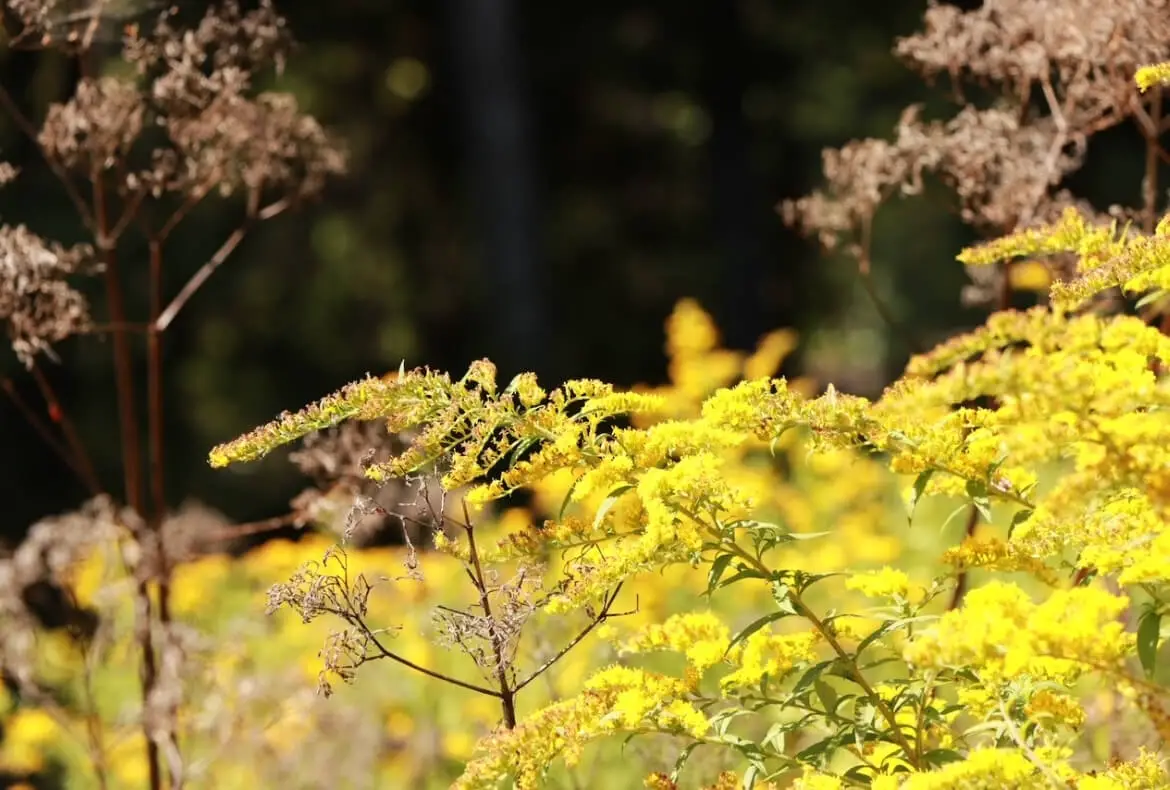

30 comments
Great post! I think the uses of Goldenrod sound awesome – I might just have to try my hand in foraging 🙂
Jenna ♥
I knew goldenrod was beneficial however I’ve never foraged for it. I love foraging. I’ll have to find a source in my area.
Thanks for sharing! We have so much goldenrod on our land and I can’t wait to try some of these recipes!
Wow! learnt so much . Had no idea it had so many benefits. Thank you, for sharing.
I absolutely LOVE goldenrod! I never knew it could be used for so many things!
What great items! Congrats with your shop!!
This is a great article, you are one of the only other people I have ever come across that uses goldenrod. It’s a magnificent medicinal that always gets overlooked. Thanks for sharing this with us at the Homestead Blog Hop, your post has been selected as one of our features this week.
Wow! Very interesting read! I had no idea you could do so much with goldenrod! Very informative article! Thanks for sharing.
This is so interesting! I would be afraid to try to identify and forage it myself since I know so little about it, but I love how you are so resourceful with nature!
Great information. My mom deals with plants, so this may be helpful for her.
Love all of your information! Thank you so much for sharing.
This is so interesting!! I love the ideas of using goldenrod for medicinal purposes
I don’t even know about this before. This is good and beneficial to our health. Thanks for sharing your knowledge about this and letting us know about it.
I am going to try the goldenrod honey, sounds lovely.
Goldenrod! When I lived in Ohio, it was the bane of my existence! It was a weed that grew everywhere, and caused me so much agony (severe allergies, only to goldenrod).
When I moved to New Mexico – where it doesn’t grow wild – I was at a nursery looking for plants, and spotted goldenrod being sold as an ornamental. As I sttod there, aghast, another woman came up and said, “Are they *really* selling goldenrod?!” Turns out that she was from Michigan. We had a good laugh about that!
Glad you found a use for it!
Yes, there are some who develop allergies toward this plant. Sorry to hear you are one of the unlucky ones! Thank you for reading & sharing your story, Suz.
Lots of great information! I really appreciate that you share your vast knowledge and experience.
I can’t believe I didn’t know all the Solidago that I love is actually goldenrod! It grows profusely where I live and I love it. A lot of people tell me it’s a weed and can’t believe I like it so much because it’s so common. But I think it’s lovely. 🙂 Didn’t realize it had so many uses too!
So many of the plants that many consider “weeds” are actually very beneficial. It does bring a beautiful display when in bloom! Thanks for stopping by, Chelsea!
So many uses for Goldenrod. I didn’t realize it was such a beneficial plant!
Thank you for this great info. This post made me think of my granddad, he was a legendary herbalist. These days i wish I had learned from him.
Oh wow! What an educational post! I am from Kazakhstan and my grandma mom used to take goldenrod. She said it helped her urinary health. But I didn’t know it also halos with arthritis…
Very interesting reading. Thank you for sharing:)
Your posts always make me excited for when we can start our homestead.
I think it is so amazing that you know so much about herbs and there uses. It is great information!
I grew up in Nebraska and Goldenrod was the state flower. I remember learning that, but never learned all of these interesting facts. Thanks.
I didn’t realize it was Nebraska’s state flower! Thank you for sharing that fact.
I can’t wait for spring to try some of these for my allergies!!
This is so interesting. I appreciated your detailed explanation how to forage for the golden rod and the many uses.
I had no idea that goldenrod could be used for so many things! Very cool information. Thank you for sharing!
Great information! I love your knowledge on making tinctures and the herbs uses!